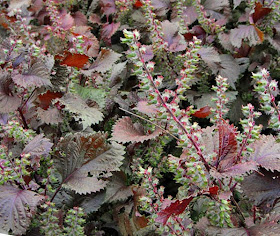Recently I've been working on a couple of magazine assignments about the hot new herbs and plants for 2014 for restaurants. My research started with new restaurant trends on-line, then I've been concentrating on interviews with chefs around the country. Not surprisingly, locally sourced produce is even bigger this year than last, new introductions of non-wheat pasta and noodles, sustainable seafood and children's menus in upscale restaurants are a few of the items.
 |
| Papalo, growing on mature plant. |
One hot new herb that surprised me a bit for this year is papalo
(Porophyllum macrocephalum), sometimes commonly dubbed "Buzzard's Breath" (although I'm guessing there won't be any chefs across the U.S. who will use that name; let's see, how might that sound on a menu..... farm-raised pork cemitas with seasonal chilies and buzzard's breath sauce...)
Used like cilantro in Bolivia, where my original seed start came from, as well in some states in Mexico, it's easy to see (or smell) why it got dubbed buzzard's breath. Just getting near the plant you'll get a whiff of something akin to aluminum with lemony overtones with some rue and other smells thrown in. That's on the mature plant, which isn't the stage of the plant normally used. The flavor has been described as something like a combination of arugula, mint and cilantro, although that doesn't quite describe it, either. The flavor is unique to the plant.
 |
| Cemitas, a Mexican sandwich. |
Papalo is also commonly eaten raw on cemitas - sometimes known as a cemita poblana, which is a Mexican sandwich and street food that originated in the city of Puebla. Papalo is also sometimes found in guacamole and in Mexico it is used fresh in soups and stews. In Bolivia native Quechua people call it Killi and eat it daily just torn up onto foods. (If you use the search button on my blog for papalo, to the right, you can find more that I've written about this interesting herb).
 |
| Papalo sold as young, pulled seedlings in Acalpulco markets. |
Papalo is showing up in gardens from California to New York City, and in markets with large Hispanic populations. However, a lot of Hispanics from other parts of Mexico or South America may not know the plant at all. I found it in the markets in Acalpulco when I visited there a few years back and admit I didn't understand the plant at all until then. I'd always let mine get to 3 or 4 feet tall and found the flavor of the leaves unpleasant. But in the markets of Acalpulco I discovered it was being grown as seedlings, the whole plant pulled up at about 12 to 15 inches tall, and the flavor of the plant was vastly better than from the mature plant.
 |
| Vendor in Mexico selling papalo. |
Even though regular cilantro
(Coriandrum sativum) is used extensively in Mexican cooking, that herb is not native to anywhere in the Americas (it is native to the eastern Mediterranean). But Papalo is native to the Americas and can be found growing wild from Bolivia northward as far as the southern U.S.
Here's a simple recipe to try when you're learning the flavors of this ancient herb. It's a simple green sauce and if you travel in Mexico, you may encounter the sauce used on eggs, sandwiches or other dishes.
8 green tomatillos, diced
1 green onion, diced
2 cloves garlic, whole
1 serrano or jalapeno chile, stem and seeds removed
4 or 5 fresh papalo leaves
1 large or 2 small avocados, diced
2 teaspoons olive oil
In a small skillet, combine the oil, tomatillos, onion, garlic and chile and simmer on medium heat until the tomatillos are soft, about 10 minutes.
Pour the ingredients into a food processor, along with the papalo leaves (I sometimes add juice of 1/2 lime, too) and pulse blend until everything is chunky-smooth.
Pour into a bowl and add the diced avocado. Let stand for about 30 minutes for flavors to blend well. Serve with chips or as a sauce on your favorite morning egg dish.
The following companies offer papalo seed:
Nichols Garden Nursery
Southern Exposure Seeds
Johnny's Selected Seeds












